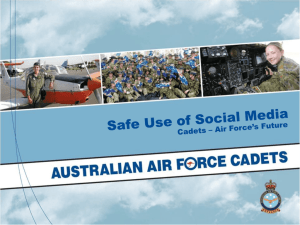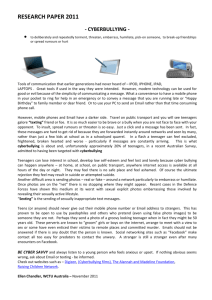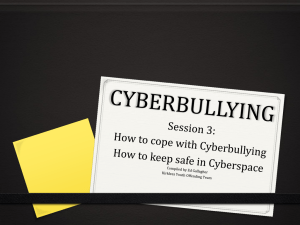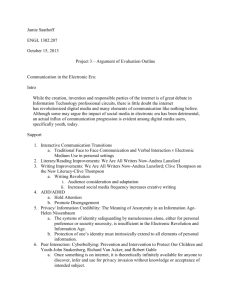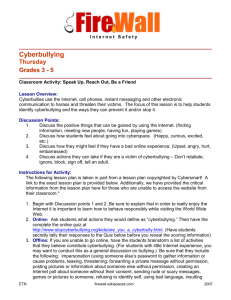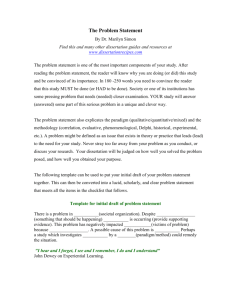File
advertisement
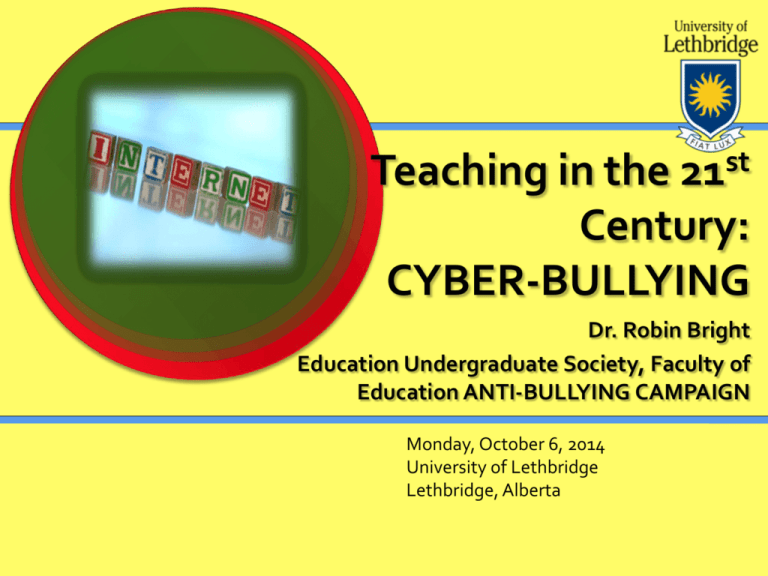
Teaching in the 21st Century: CYBER-BULLYING Dr. Robin Bright Education Undergraduate Society, Faculty of Education ANTI-BULLYING CAMPAIGN Monday, October 6, 2014 University of Lethbridge Lethbridge, Alberta Cyberbullying http://www.youtube.com/watch?v=bfT2qqrqzgo It’s not about the technology… A key point to understanding technology and children is to keep in mind that the core issue is not about the technology. For children and teens, technology and life online is all about connection, relationships and friends. The technology is simply a vehicle. ChildrenOnline.org Cyberbullying What is it? • Willful harm inflicted through electronic media • Use of electronic devices to threaten, harass, embarrass, socially, exclude, or damage reputations and friendships Key Research Findings Bullying perpetration rates range from 4-18 % Victimization rates are considerably higher at 7-35% Cyberbullying tends to be low in grade 5, peak in grade 8, and decline by grade 11 Over 50% of youth who are cyberbullied don’t inform any adulst about the incidents Less than 35% of students would inform adults if/when they knoew about someone else being cyberbullied How vulnerable are you to cyberbullying and cybercrime? Digital Footprints Personal information of yourself, friends and family Sharing passwords Connections with people you don’t know Plans and vacancies Quizzes, prizes, samples and products Peer-to-peer software Online gaming disclosure Images and video Cyber Talk (2006-2008) • 676 cyberbullying comments • “Describe a situation you know about in which someone was the bully or bullied online and what happened as a result.” (http://cybertalk.ca/) Forms of Cyberbullying Harassment Denigration Impersonation and Pretending Outing or Trickery Exclusion Threats and Violence Cyberstalking Frenemies Cyberbullying 37% know someone who has been bullied online 19% have been bullied themselves online (target) 17% have bullied others online Online Social Norms (cyberbully.org) Life online is just a game. Look at me. I am significant. It’s not me- it’s my online persona. What happens online stays online and has no real world consequences. If the internet lets me do it, it must be okay. Only the people I intend to see what I post will look at it. I have the right to free speech; to write or post anything I want regardless of the harm it may cause another person. Cell phones • Parents provide them for safety • Youth use them for texting (avg. 81 daily) • Under 14 , consider no text, no camera. • Adults model appropriate usage. • School policies must educate. Who are the cyberbullies? The Importance of Teacher Response to Cyberbullying Mishna et. al (2005) found that… “Teacher training is critical in identifying and responding to (cyber)bullying. Teachers require, and want, further training to increase their confidence and competence in this area.” Teacher education Teachers need: 1. To have a clear definition of bullying 1. To know that their understanding and response can have an effect of students 2. To recognize inconsistencies between their views and their reactions to cyberbullying 3. To know a child’s view may differ from their own The Role of Adults in Positive Intervention Adults need to talk to youth about cyberbullying-letting them know they will be supportive Reduction of harm approach: education on net-etiquette and safety (prosocial behavior) Adults need to make it clear that online and cell phone privileges will not be revoked is cyberbullying is reported Conduct more work with intervention and prevention programs Recognizing the Problem • Talk and acknowledge cyberbullying. • Be accessible. • Be alert to anxiety, emotional distress and withdrawal. • Watch for changes in behavior. • Appearing emotionally upset after internet use. • Disturbed relationships with parents, family and friends. • Subtle comments about online concerns. How? Jenn Cowie (Wilson Middle School) The Wilson Way: Technology, Literacy, Leadership Six-week mandatory exploratory option An emphasis on developing strong communication skills through technology prepares students to interact effectively in our changing world. ICT Outcomes and 9 Pillars of Understanding The ICT curriculum presents concepts within three interrelated categories: • communicating, inquiring, decision making and problem solving • foundational operations knowledge concepts • processes for productivity Who can help? Creating Caring, Respectful, and Safe Learning Environments-Alberta Education and The ATA http://education.alberta.ca/admin/supportingstudent/sa feschools.aspx School Resource Officers Techno Brain State of continuous partial attention Reduced learning Reduced time spent with peers Reduced physical activity Identity construction. What to do? STOP, BLOCK, TALK AND SAVE read privacy policies and settings restrict access to your sites take precautions when meeting people you have met online. The billboard test. Stop ~Think~ Connect Best Practices for Schools 1. Introduce Internet safety education early. 2. Revisit and spiral skills each year from elementary through high school. 3. Select topics that are developmentally appropriate and reflect the typical risks and issues facing a particular age group. 4. Create units for developmental age groups with topics that can integrate with existing curriculum. 5. Use quality curricular materials AND current events to teach Internet Safety topics. 6. Provide students with a lot of opportunity to discuss these issues. 7. Provide opportunities and a forum for parent education and discussion. Resources http://education.alberta.ca/admin/supportingstudent/safescho ols.aspx http://mediasmarts.ca/ http://mediasmarts.ca/sites/mediasmarts/files/pdfs/lessonplan/Lesson_Winning_Cyber_Security_Game.pdf http://mediasmarts.ca/sites/mediasmarts/files/pdfs/publicationreport/summary/YCWWIII_Cyberbullying_ExecutiveSummary_2.p df http://www.iste.org/ http://www.prevnet.ca/ http://cehs15.unl.edu/cms/index.php?s=2&p=124 Questions
